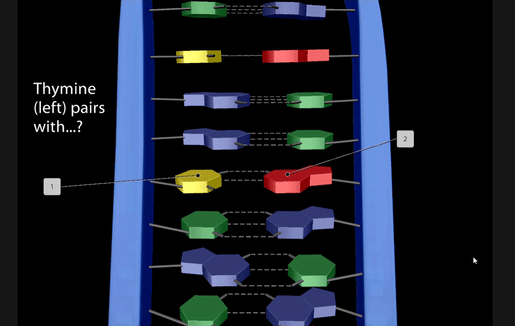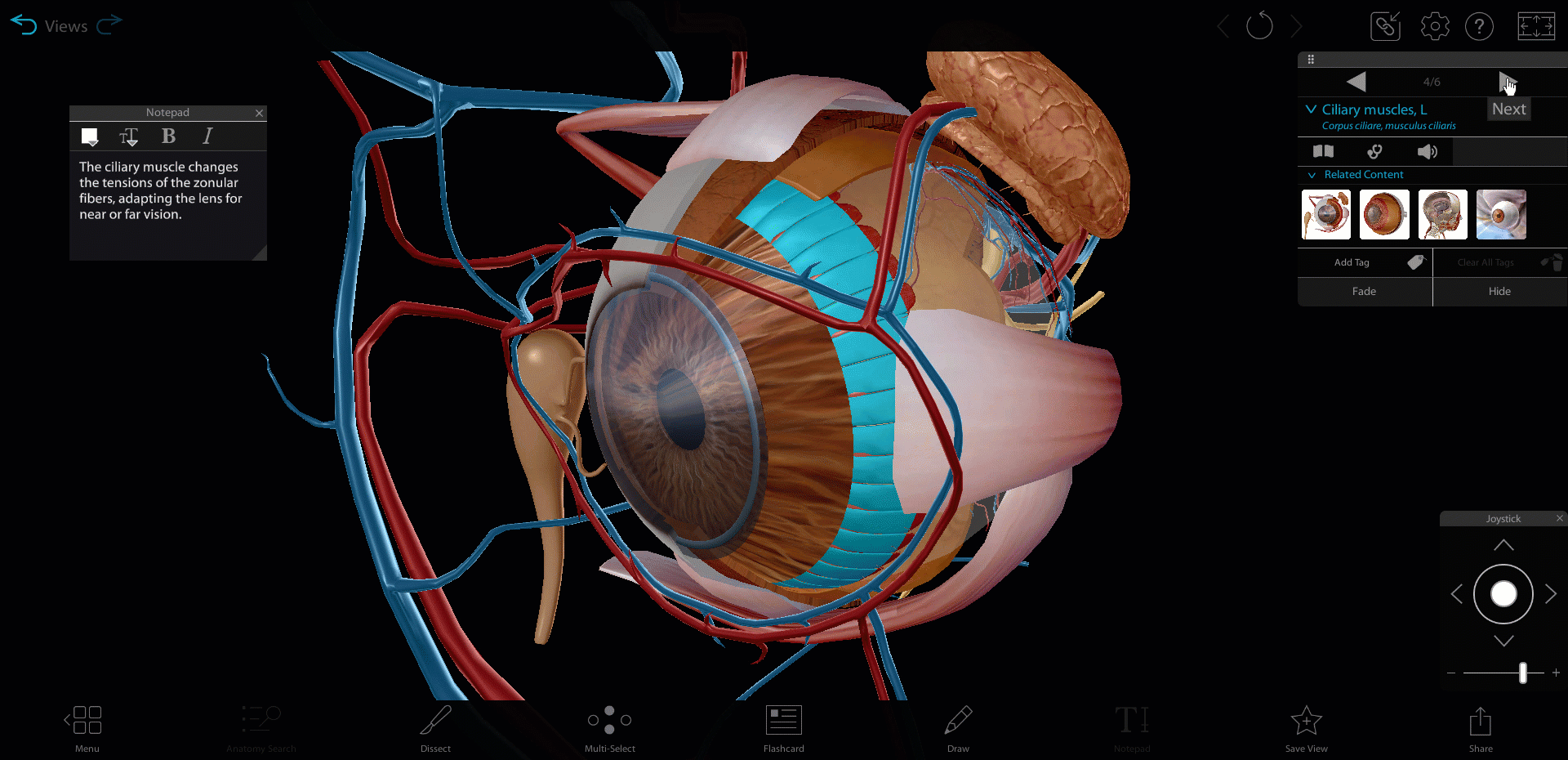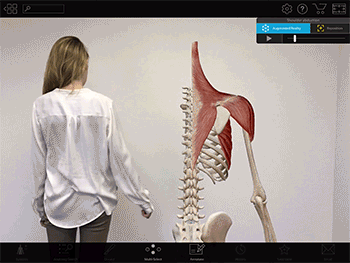How Visible Body Supports Executive Function Skills
Posted on 7/15/22 by Jennifer Kravitz
It’s 11:30 pm. You’re a student who needs to take a final exam online in your hybrid course. It’s timed, and it’s due at midnight. Procrastination has been your only approach to prepare up until this point. You’ve read over some of your class notes, and flipped through PowerPoint presentations in the last half hour. The lab report you turned in is saved on your computer, but you dread scrolling through 39 pages of the PDF document or rifling through that stack of papers stuffed into a random folder in your backpack. What’s the point of even trying to study now? And how did you get here? Your anxiety grows, and the clock ticks on.
These situations highlight that students require more than intelligence and access to research skills to succeed: they need executive function skills. These are the skills that help you reach your goals.
Today on the Visible Body Blog, we’ll connect Visible Body’s features and products to these crucial skills.
What are executive function skills?
Much like a conductor of an orchestra or the principal of a school, a student of any age needs to engage and manage all sorts of executive function skills simultaneously, such as:
- Self regulation: keeping emotions and impulses in check to keep going
- Working memory: remembering information learned, making instant connections to build knowledge
- Sustained attention: maintaining attention, even when bored or preoccupied
- Cognitive flexibility: switching between multiple concepts simultaneously, and adapting to new circumstances
- Task initiation: getting started, even when unmotivated or overwhelmed
- Planning: mapping out short- or long-term action steps over time
- Prioritizing: putting the most urgent or important things first
- Time management: being aware of and allocating time for required activities
- Data and materials organization: keeping important materials and information in a systematic way
- Metacognition: awareness about how your mind works, and what the best strategies are to apply for learning
Preparing for an exam requires many executive function skills: students need to
- Get themselves to a pre-dedicated study space
- Get started with independent studying
- Block out social media notifications
- Remember to schedule a study group well in advance of the test
- Overcome their dread and fear of failure
- Ignore their wandering thoughts and app notifications
- Break down sections to study and map them out on a calendar before the exam date
- Stick to their study plan
- Keep information and materials where they need them when they need them Notice when a study method isn't working and change it
Add in an abrupt change from in-class to all-online learning due to a pandemic, then switching back to all in-person lab and lectures, and executive function tools become even more in demand.
Before assuming a student is lazy or not cut out for academics, it’s critical that all parties understand it takes time, awareness, and effort to improve these skills. In the meantime, instructors can rely on tools and systems that support students as they develop executive function skills.
Through features like 3D models and Flashcards and products like Courseware, Visible Body’s teaching and learning platform, students can develop their knowledge of biology, anatomy, and physiology and develop the skills they need to succeed in the classroom and beyond.
Memory management, sustained attention, cognitive flexibility, metacognition, and self-regulation
Depending on your profile, this collection of executive function skills can be extra challenging. Let’s look at two examples of how Visible Body helps to improve them and build students' working memory.
Learning in a flash
Imagine you’re a student going through the Visible Body Suite Flashcard Deck your instructor assigned in Courseware to help you prep for next week’s exam. You can identify where the aorta is, but forget what it does when that flashcard pops up and asks for its function.
To support your working memory, you return to the Flashcard, select Explore in 3D, and instantly find its name, a textbook definition, common pathologies, and structures that surround it. You watch a related content video about how cardiac output drives the way blood flows through the heart, what cardiac reserve is, and factors that influence cardiac output.
You return to the flashcard, test yourself again, and you not only earn that green thumbs up, you add notes to the deck that you think will help you remember the aorta based on your exploration. The next day, when you go through your customized deck, you not only remember the structure, but also related information that helped you retain it. Going forward, you’re motivated to create your own custom flashcard deck because you’ve experienced how hands-on learning helps you remember course material longer.
 Flashcard made in Visible Biology.
Flashcard made in Visible Biology.
Remember by doing
Students need to interact with materials in a meaningful way to best remember what they learn. Instructors need to provide those opportunities as much as possible, which in turn engages executive function skills that help students learn and retain information.
It’s important to remember that human brains work the way they do for evolutionary purposes. Some knowledge or information becomes less adaptive to recall in certain survival-dependent situations. After all, from an evolutionary and survival standpoint, it’s not adaptive to ruminate on the food we ate one month ago or reimagine all the beautiful sunsets we ever saw when faced with a stampede of predators charging our way. Check out this article for a great description of this cognitive phenomenon, and how understanding it can help us manage and remember more.
For instructors, this brain science is key to understanding the best way to support long-term student learning. The ideas that stick the most in our brains are learned through experience.
If participatory teaching methods, such as discussion groups, practice by doing, or teaching others offer the highest levels of knowledge retention, how do we incorporate them in lesson and unit planning?
It’s no secret that an in-person lab activity brings this “practice by doing” approach to the fore.
An instructor wants to teach about lever systems in the human body. Which activity will help them remember what they learn?
Only reading 2D learning material—
 Photo via Hubspot.
Photo via Hubspot.
—or pairing this activity with a 3D interactive Tour that students can create, annotate, and share in a study group?
 GIF from Visible Body Suite.
GIF from Visible Body Suite.
Which shoulder muscle action lesson will encourage students to remember the physiological processes of muscle actions in six months?
Only filling out the worksheet—
.png?width=515&name=My%20project%20(9).png)
Screenshot from a Visible Body lab manual.
—or pairing it with this lab activity, in which students work together to create video reenactments as physical therapists and patients, then present them to the class?

GIF created using Visible Body Suite.
As this blog article about 3D learning featuring Vice President of Creative Services Bert Oppenheim reminds us, it will be the interactive, multidimensional approach every time. Visible Body can help instructors engage executive function skills by incorporating multimodal, multisensory techniques, such as those described in this blog about alternative assessments.
Participation and metacognition
Metacognition skills allow students to realize which learning approaches work best, making interactive, multimodal learning activities such as these their first choice for learning. Emotionally, students feel accomplished and motivated to advance on their learning journey. Courseware gives instructors the tools to make participatory learning the fundamental way of learning. Students remember information from the hands-on experience through our 3D interactive models, and can even teach others in study groups using custom content, such as Views, Flashcards, or Tours.
|
Executive function skill |
|||||
|
Visible Body feature |
Response inhibition/ Self regulation |
Working memory |
Sustained attention |
Cognitive flexibility |
Task initiation |
|
3D models |
X |
X |
X |
X |
X |
|
Flashcards/Decks (self-made even more beneficial) |
X |
X |
X |
X |
X |
|
Courseware |
X |
X |
X |
X |
X |
|
Animations/media |
X |
X |
X |
X |
X |
|
Tours |
X |
X |
X |
X |
X |
|
Custom content |
X |
X |
X |
X |
X |
|
Practice quizzing |
X |
X |
X |
||
|
Lab activities, PDF |
X |
||||
|
Lab activities, autograded |
X |
X |
X |
X |
|
|
A&P app |
X |
X |
X |
||
Task initiation, time management, planning and prioritizing, data organization
Instructors rely on class tools and frameworks to help students accomplish tasks on time and with great results. That’s where Courseware makes a big difference. It checks all the boxes when it comes to organizing instructor and student data, prioritizing what tasks should be done when, and establishing where to begin.
Courseware was built with structural supports and efficiency in mind. Each course has a Dashboard that sets both students and instructors up for success by supporting executive function skills comprehensively.
- Graded and ungraded assignments feed into the Courseware Gradebook with due dates and release dates that can be edited and published in bulk to help students with long-term planning.
- The Calendar provides classic time management for students.
- The Roster manages timed quizzing to customize and accommodate as needed or required.
- The Gradebook provides automatically updated grade tracking, building performance awareness for students. Instructors can provide extensions and additional quiz attempts to adjust for students with executive function challenges.
- Course Resources and Announcements pages provide one-stop reference for efficient data organization and retrieval for students.
|
Executive function skill |
|||
|
Visible Body feature |
Planning, prioritizing, time management |
Data organization |
Metacognition |
|
3D models |
X |
X |
|
|
Flashcards/Decks (self-made even more beneficial) |
X |
X |
X |
|
Courseware |
X |
X |
X |
|
Animations/media |
X |
||
|
Tours |
X |
X |
X |
|
Custom content |
X |
X |
X |
|
Practice quizzing |
X |
X |
|
|
Lab activities, PDF |
X |
X |
|
|
Lab activities, autograded |
X |
X |
X |
|
A&P app |
X |
X |
X |
The Power of Visible Body
Exploring Visible Body content apps individually is fun and engaging for students and instructors alike. When you pair the structure and sequential progression of completing a course in Courseware (appealing to executive function needs) with the wonder of 3D interactive exploration and endless creative possibilities, the result is powerful.
Dr. Cindy Harley saw an improvement in her own students’ grades after switching from a textbook to Visible Body. To find out if other instructors saw similar changes to their own students’ grades, she reached out to colleagues at five institutions and gathered some data with a survey. Pre-Covid-19 pandemic results indicated that, when used for formative assessment and supplemental or replacement course material for textbooks:
- 19% more students earned As
- Grades went up 6.65% on average
- 8% more students stuck with courses
- Instructors found VB easy and enjoyable to use (4.8/5.0 on the Likert scale)
These results suggest that when there's a more engaging way to learn, there's a will to excel. Motivated, engaged students do well, and motivated, engaged instructors teach well. When executive function skills are supported with tools such as Visible Body, learning sticks.
Be sure to subscribe to the Visible Body Blog for more anatomy awesomeness!
Are you an instructor? We have award-winning 3D products and resources for your anatomy and physiology course! Learn more here.



